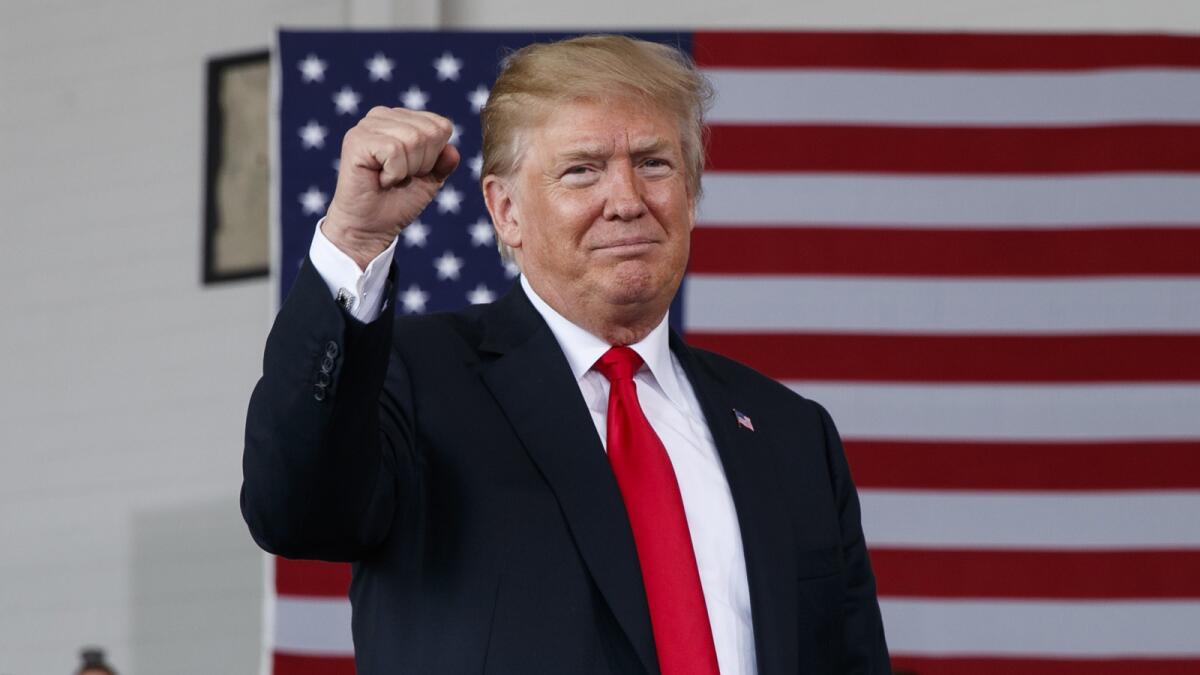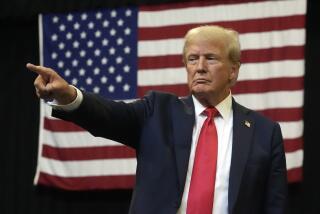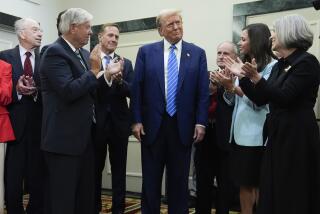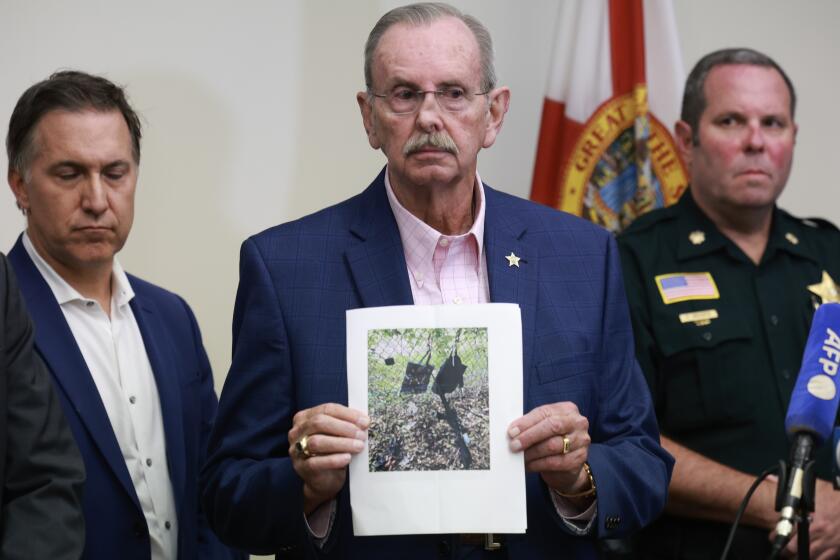Trump returns from a brief trip to greater tumult of his own making in Washington

President Trump was only out of Washington for 36 hours this week, for an overnight trip to California and, on Wednesday, to St. Louis. He returns to even more tumult than he’d left, largely the fallout of his own actions on his way out of town.
Besides creating heightened uncertainty throughout his top ranks about the standing of major advisors, even speculation about a purge, Trump also confronts elevated concerns in his party for its congressional majorities after Republicans apparently lost a special election in which he was an underlying issue.
Trump set much of the new round of chaos in motion on Tuesday morning with a tweet announcing the firing of Secretary of State Rex Tillerson, followed by his comments to reporters as he left the White House for California suggesting he might replace other Cabinet secretaries.
Among those widely reported as possible short-termers are U.S. Atty. Gen. Jeff Sessions, national security advisor H.R. McMaster, Veterans Affairs Secretary David Shulkin, White House Chief of Staff John F. Kelly and Housing and Urban Development Secretary Ben Carson.

President Trump visited California for the first time as president March 13.
MORE: Full coverage of Trump’s visit »
Trump’s chief economic advisor, Gary Cohn, had only disclosed his resignation last week, and on Wednesday the White House announced that he would be replaced by Larry Kudlow, a former Reagan administration official and conservative television commentator who has informally advised Trump since his campaign.
In his comment on Tuesday that suggested more upheaval to come, Trump told reporters, “I’m really at a point where we’re getting very close to having the Cabinet and other things that I want.”
Yet the president has sent conflicting signals over what exactly he does want. Last week, he said, “I like conflict. I like having two people with different points of view.” After firing Tillerson, however, he said he needed somebody on his own “wavelength.”
Political allies are expecting more changes, seeing them as part of a pattern for Trump, who as a businessman and a presidential candidate liked to shuffle players around.
“I see this as Trump asserting himself,” said Michael Pillsbury, a senior fellow at the Hudson Institute who advised Trump during the transition and remains in regular contact with the administration.
Jason Miller, a former campaign aide, said: “Trump is sending a clear message that if you’re not pulling your weight, you’ll be shipped out.”
“The president is realizing he was slow-walked by people around him. And now he’s taking matters into his own hands and doing what he said he was going to do when he took office in the first place,” Miller added.
When asked on Wednesday whether Shulkin would be the next to go, Deputy Press Secretary Raj Shah would say only that he “had not heard that for certain.” The V.A. chief is the subject of internal investigations of his management as well as media reports of serious dissension among his aides.
“The president has confidence in his entire team,” Shah told reporters aboard Air Force One. “When he does not, you guys will know about it.”
The ouster of Tillerson, who will remain at the State Department until the end of the month, comes at an unsettling time. Trump has agreed to a risky face-to-face meeting with North Korean Leader Kim Jong Un, and has rattled allies both by his proposed tariffs on steel and aluminum imports and by his slow and tepid response to Britain’s charge that Russia poisoned a former spy and his daughter on British soil.
Tillerson’s firing came a day after he joined Britain in blaming the Russians and warning of reprisals. Trump stood silent on who was to blame for two days. On Wednesday, United Nations Ambassador Nikki Haley said the United States stood with Britain, yet the White House had no response to match British Prime Minister Theresa May’s expulsion of 23 Russian diplomats, a reminder of Trump’s failure to act on Russia’s election meddling.
In a statement late Wednesday, the White House expressed support for Britain’s actions, but announced no responses of its own against Russia.
Trump faces greater challenge on the domestic front after the candidate he endorsed in a Pennsylvania congressional district, Republican Rick Saccone, apparently lost a close special election on Tuesday to Democrat Conor Lamb. Trump had carried the region by 20 percentage points in 2016.
Republicans were publicly dismissive of the close special election, which they might contest, saying that Saccone wasn’t a good candidate and Lamb “ran a pro-Trump playbook on policy,” as one senior White House official said, declining to be named discussing electoral politics. Shah, the spokesman, argued that Trump’s campaigning for Saccone at a Saturday rally in western Pennsylvania prevented an even worse showing for Saccone.
Contrary to the White House characterization of Lamb’s positions, the Democrat ran against Trump’s agenda on healthcare and taxes.
“Clearly one of the messages is candidates matter,” said Sen. John Thune, a South Dakota Republican who is the third-ranking lawmaker in the Senate. “Secondly, we need to take a message.”
If history proves a guide, the defeat is likely to further weaken Trump’s sway in Congress, where many GOP lawmakers had already been losing confidence in his ability to stick to a position on legislation or carry candidates to victory.
For Republicans already fretful about their prospects in the midterm elections — fearful of losing control of the House if not the Senate, too — the apparent loss in Pennsylvania was widely seen as a particularly ill omen.
As Trump bragged about a humming economy during the event at Boeing in Missouri, Democrats nationwide were seeing signs of the potential to capitalize on the new energy of young people and suburban women spurred into activism after last month’s mass shooting at a high school in Parkland, Fla.
Students around the country marched out of their schools on Wednesday, hoping to put pressure on Trump and lawmakers to buck the National Rifle Assn. and back new limits on guns. Trump had promised to do so before retreating earlier this week. The activists are planning larger protests and marches for March 24.
Even so, the degree of concern among Republicans varies by candidate and region. In California, for example, where Trump is deeply unpopular and was greeted by protests on Tuesday during his first visit as president, most Republicans stayed away from his public appearances.
But in St. Louis on Wednesday, Trump met an enthusiastic crowd of supporters at the airport and shouts of “Keep it up!” when he arrived at a Boeing plant for a roundtable promoting his tax cuts. Missouri Atty. Gen. Josh Hawley, who is among Republicans vying to challenge Democratic Sen. Claire McCaskill in November’s midterm election, was among the greeters. Trump singled him out for “doing a fantastic job.”
In contrast to his sharp critique of blue-state California on Tuesday, Trump said Missouri “was very good to me” in the election.
Los Angeles Times staff writer Cathleen Decker contributed from Washington. Bierman reported from Washington. Bennett reported from St. Louis.
More to Read
Get the L.A. Times Politics newsletter
Deeply reported insights into legislation, politics and policy from Sacramento, Washington and beyond. In your inbox three times per week.
You may occasionally receive promotional content from the Los Angeles Times.












